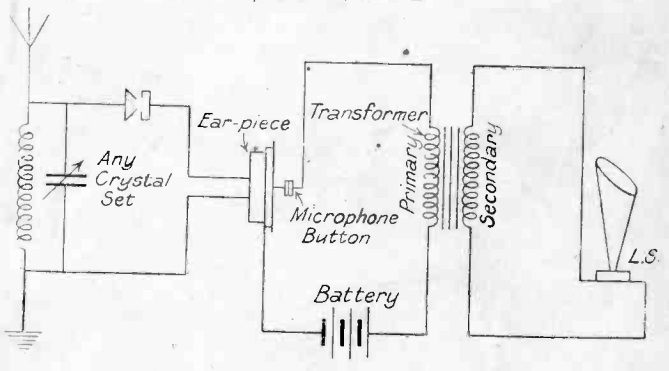While they were rarely used in radio applications, the diagram here shows how a carbon button microphone amplifier could be used to drive a loudspeaker from a crystal set. This diagram is from 90 years ago, and appeared in the 1927 British Radio Year-Book. The diagram actually appears in the advertisement for a book entitled Successful Crystal and One Valve Circuits by J.H. Watkins, who according to the ad was the wireless correspondent for the Daily Express.
The principle behind the circuit is very simple and almost self-explanatory. The audio from the crystal set or other low-level source is fed to the traditional earphone. A carbon button microphone is in physical contact with the earphone, and produces a stronger AF signal. In this case, this stage is able to drive a loudspeaker.
This idea was rarely used in radio, since a vacuum tube amplifier provided better results and little additional cost. The carbon button amplifier was more commonly used in telephone circuits, where they were the only method of amplification available prior to the vacuum tube. They made long distance telephony possible. They did have the advantage of a smaller size than a vacuum tube, and required less battery power. Therefore, they did remain in use in hearing aids until the advent of the transistor three decades later. You can read more about the carbon button amplifier at this site.
The advantage for the home constructor was probably cost, since driving a speaker this way would not require an expensive vacuum tube. In fact, the carbon button amplifier could probably be constructed at home, which would be impossible in the case of a vacuum tube. Students looking for a very novel science fair project might consider making one, since it would be possible to produce loudspeaker volume with entirely homemade components.


Very interesting piece of history! It’s crazy how something that was incredibly relevant to long-distance phone calls and hearing aids could be practically forgotten to history when a more practical piece of technology comes along (which itself has since fallen out of fashion due to new technology!).
Hope you don’t mind but thanks, I used the circuit diagram in a page I’m putting together on my own website.
https://nextexx.com/microphone-coherer-extraordinary/